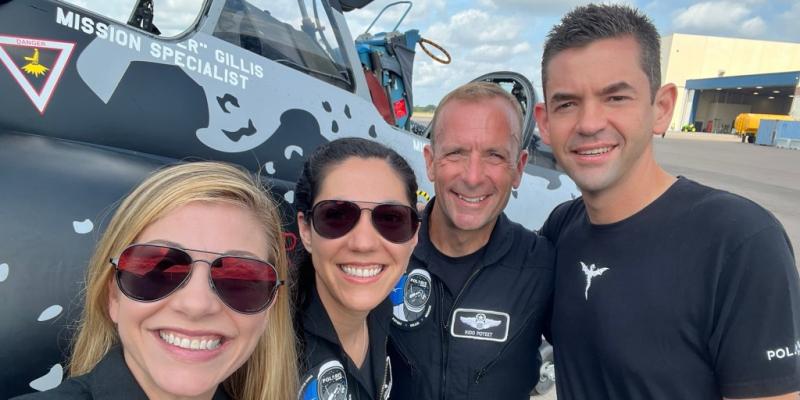SpaceX's Polaris Dawn mission will feature first private spacewalk



Four private citizens are set to launch on an ambitious, first-of-its-kind space mission next week that is expected to include the first spacewalk conducted entirely by a commercial crew.
The mission, dubbed Polaris Dawn, is scheduled to lift off Monday from NASA's Kennedy Space Center in Florida sometime between 3:30 a.m. and 7 a.m. ET.
Billionaire entrepreneur Jared Isaacman, founder and CEO of the payment processing company Shift4, will be commander of the Polaris Dawn flight. It's the first of three planned spaceflights that Isaacman is funding and organizing in partnership with SpaceX, collectively known as the Polaris program. Isaacman launched to space as part of the first all-civilian SpaceX mission to orbit in 2021.
The mission's three other crew members are Scott "Kidd" Poteet, a retired Air Force lieutenant colonel who will be the pilot, and two SpaceX engineers, Sarah Gillis and Anna Menon.
They will ride into space in a SpaceX Crew Dragon capsule atop a Falcon 9 rocket. The plan for the five-day mission is to send them to an orbital altitude more than three times higherthan the International Space Station — the highest that humans have reached since the final Apollo moon mission in 1972.
Three days into the flight should come the spacewalk, in which two crew members will exit the capsule on a tether for up to 20 minutes.Previously, only astronauts from government space agencies have conducted spacewalks to build or upgrade space stations in orbit, repair satellites and complete science experiments.
The Polaris Dawn spacewalk is scheduled at an altitude of 435 miles above Earth. Because the Crew Dragon spacecraft does not have an airlock, the entire capsule will be exposed to the vacuum of space during the planned outing.
As a result, all four astronauts — including the two remaining inside — will wear and test spacesuits SpaceX designed for future long-duration missions.
"The idea is to learn as much as we possibly can about this suit and get it back to the engineers to inform future suit design evolutions," Isaacman said Monday in a news briefing from the Kennedy Space Center.
Isaacman and his fellow crew members spent the past two years training for the flight.
"Throughout our mission, we will aim to inspire humankind to look up and imagine what we can achieve here on Earth and in the worlds beyond our own," Isaacman said in a statement Monday.
The mission plan calls for the commercial astronauts to conduct dozens of scientific experiments and test laser-based satellite communication using SpaceX's Starlink satellites during their five days in space.
Their Crew Dragon capsule will soar to altitudes of up to 870 miles above the planet's surface — distant enough to move through parts of the inner Van Allen radiation belt, a donut-shaped zone of high-energy radiation particles that are trapped in place by Earth's magnetosphere.
The flight is designed to study the health of the astronauts and their spacecraft in different space radiation environments. Such research will be valuable for planning future missions to the moon and Mars, because astronauts must fly though the inner and outer Van Allen radiation belts to reach outer space.
In a statement, Poteet called the mission "the pinnacle of my flying career."
He spent 20 years as a military fighter pilot and was the mission director on the ground during Isaacson's 2021 trip to orbit.
"I'm so thankful for the opportunity to head into space," Poteet said.
The SpaceX engineers accompanying Poteet and Isaacson have similarly labored behind the scenes on commercial spaceflights. Gillis, a lead space operations engineer at SpaceX, oversees its astronaut training program. Menon, also a SpaceX lead space operations engineer, has served in the company's mission control center.
The Polaris Dawn mission will raise money for St. Jude Children's Research Hospital, as Isaacman did on his previous journey to space.
Isaacman declined to reveal the cost of the Polaris Dawn mission and has not publicly discussed the possible objectives or timeline for the second and third Polaris flights.



If this pans out. . . commercialized Space. What can go wrong? Plenty. (Just look at the 'ups' and 'downs' humans cause on Earth when capitalism is involved. And we have not even begin to have the discussion of what dictators and tyrants will do with their advances.
Exactly, government space travel and satellites are fool proof and more affordable.
Then don't you think that we had better advance at a faster rate then them? If it takes commercialization and capitalism to advance us into space then so be it.
If you don't do, then how do you learn.
Good point! But now I do have to come forward and state that I have a developing problem with the CEO of Space X. He has aligned himself with Donald Trump, a professional charlatan. . . and I am now wondering what such an "alliance" and alliances between ambitious personages delineate for the Space surrounding and beyond the Earth!
To be clear- er , Elon Musk has given me reason to question his judgement/decision-making. And other billionaire tycoons who are 'turning' to the stars above us, as to what they will be up to unsupervised out there. That is what I mean by my criticism.
Incidentally, Elon has parked a mock 'car' out there in space. . .
STARMAN Tesla Roadster Live Position and Data
All I can say is stay safe out there.